Tunable Photonic Hook Design Based on Anisotropic Cutting Liquid Crystal Microcylinder
Abstract
1. Introduction
2. Materials and Methods
3. Results
3.1. Plane Wave
3.2. Gaussian Beam
3.3. Bessel Beam
4. Conclusions
Author Contributions
Funding
Institutional Review Board Statement
Informed Consent Statement
Data Availability Statement
Acknowledgments
Conflicts of Interest
Abbreviations
| FDTD | Finite-Difference Time-Domain |
| PH | photonic hook |
| LC | liquid crystal |
| FWHM | full width at half maximum |
| TE | transverse electric |
| PNJ | photonic nanojet |
References
- Ashkin, A.; Dziedzic, J.M.; Yamane, T. Optical trapping and manipulation of single cells using infrared laser beams. Nature 1987, 330, 769–771. [Google Scholar] [CrossRef] [PubMed]
- Moffitt, J.R.; Chemla, Y.R.; Smith, S.B.; Bustamante, C. Recent advances in optical tweezers. Annu. Rev. Biochem. 2008, 77, 205–228. [Google Scholar] [CrossRef] [PubMed]
- Bao, Y.; Yu, S.S.; Anderegg, L.; Chae, E.; Ketterle, W.; Ni, K.K.; Doyle, J.M. Dipolar spin-exchange and entanglement between molecules in an optical tweezer array. Science 2023, 382, 1138–1143. [Google Scholar] [CrossRef]
- Riccardi, M.; Martin, O.J. Electromagnetic forces and torques: From dielectrophoresis to optical tweezers. Chem. Rev. 2023, 123, 1680–1711. [Google Scholar] [CrossRef] [PubMed]
- Essiambre, R.J. Arthur ashkin: Father of the optical tweezers. Proc. Natl. Acad. Sci. USA 2021, 118, e2026827118. [Google Scholar] [CrossRef]
- Resnick, A. Use of optical tweezers for colloid science. J. Colloid Interface Sci. 2003, 262, 55–59. [Google Scholar] [CrossRef][Green Version]
- Li, J.; Chen, Z.; Liu, Y.; Kollipara, P.S.; Feng, Y.; Zhang, Z.; Zheng, Y. Opto-refrigerative tweezers. Sci. Adv. 2021, 7, eabh1101. [Google Scholar] [CrossRef]
- Ðorđević, T.; Samutpraphoot, P.; Ocola, P.L.; Bernien, H.; Grinkemeyer, B.; Dimitrova, I.; Vuletić, V.; Lukin, M.D. Entanglement transport and a nanophotonic interface for atoms in optical tweezers. Science 2021, 373, 1511–1514. [Google Scholar] [CrossRef]
- Kim, M.E.; Chang, T.H.; Fields, B.M.; Chen, C.A.; Hung, C.L. Trapping single atoms on a nanophotonic circuit with configurable tweezer lattices. Nat. Commun. 2019, 10, 1647. [Google Scholar] [CrossRef]
- Gordon, R. Biosensing with nanoaperture optical tweezers. Opt. Laser Technol. 2019, 109, 328–335. [Google Scholar] [CrossRef]
- LaFratta, C.N. Optical tweezers for medical diagnostics. Anal. Bioanal. Chem. 2013, 405, 5671–5677. [Google Scholar] [CrossRef]
- Choi, W.J.; Park, K.S.; Eom, T.J.; Oh, M.K.; Lee, B.H. Tomographic imaging of a suspending single live cell using optical tweezer-combined full-field optical coherence tomography. Opt. Lett. 2012, 37, 2784–2786. [Google Scholar] [CrossRef]
- Liang, S.; Cao, Y.; Dai, Y.; Wang, F.; Bai, X.; Song, B.; Zhang, C.; Gan, C.; Arai, F.; Feng, L. A versatile optoelectronic tweezer system for micro-objects manipulation: Transportation, patterning, sorting, rotating and storage. Micromachines 2021, 12, 271. [Google Scholar] [CrossRef]
- Ren, Y.; Chen, Q.; He, M.; Zhang, X.; Qi, H.; Yan, Y. Plasmonic optical tweezers for particle manipulation: Principles, methods, and applications. ACS Nano 2021, 15, 6105–6128. [Google Scholar] [CrossRef]
- Li, H.; Ren, Y.; Li, Y.; He, M.; Gao, B.; Qi, H. Nanoparticle manipulation using plasmonic optical tweezers based on particle sizes and refractive indices. Opt. Express 2022, 30, 34092–34105. [Google Scholar] [CrossRef]
- Chen, Z.; Taflove, A.; Backman, V. Photonic nanojet enhancement of backscattering of light by nanoparticles: A potential novel visible-light ultramicroscopy technique. Opt. Express 2004, 12, 1214–1220. [Google Scholar] [CrossRef] [PubMed]
- Yang, H.; Trouillon, R.; Huszka, G.; Gijs, M.A. Super-resolution imaging of a dielectric microsphere is governed by the waist of its photonic nanojet. Nano Lett. 2016, 16, 4862–4870. [Google Scholar] [CrossRef]
- Wen, Y.; Yu, H.; Zhao, W.; Wang, F.; Wang, X.; Liu, L.; Li, W.J. Photonic nanojet sub-diffraction nano-fabrication with in situ super-resolution imaging. IEEE Trans. Nanotechnol. 2019, 18, 226–233. [Google Scholar] [CrossRef]
- Chen, W.Y.; Liu, Y.Y.; Kong, J.A.N.; Li, L.P.H.; Chen, Y.B.; Cheng, C.H.; Liu, C.Y. Biological cell trapping and manipulation of a photonic nanojet by a specific microcone-shaped optical fiber tip. Opt. Lett. 2023, 48, 1216–1219. [Google Scholar] [CrossRef] [PubMed]
- Li, Y.C.; Xin, H.B.; Lei, H.X.; Liu, L.L.; Li, Y.Z.; Zhang, Y.; Li, B.J. Manipulation and detection of single nanoparticles and biomolecules by a photonic nanojet. Light. Sci. Appl. 2016, 5, e16176. [Google Scholar] [CrossRef] [PubMed]
- Siviloglou, G.; Broky, J.; Dogariu, A.; Christodoulides, D. Observation of accelerating Airy beams. Phys. Rev. Lett. 2007, 99, 213901. [Google Scholar] [CrossRef] [PubMed]
- Efremidis, N.K.; Chen, Z.; Segev, M.; Christodoulides, D.N. Airy beams and accelerating waves: An overview of recent advances. Optica 2019, 6, 686–701. [Google Scholar] [CrossRef]
- Minin, I.V.; Minin, O.V. Photonic Jets Formation by Non Spherical Axially and Spatially Asymmetric 3D Dielectric Particles. In Diffractive Optics and Nanophotonics: Resolution Below the Diffraction Limit; Springer: Berlin/Heidelberg, Germany, 2016; pp. 31–54. [Google Scholar]
- Minin, O.V.; Minin, I.V. The Photonic Hook: From Optics to Acoustics and Plasmonics; Springer: Cham, Switzerland, 2021. [Google Scholar]
- Ang, A.; Karochevsky, A.; Minin, I.; Minin, O.; Sukhov, S.; Shalin, A. Photonic Hook’based optomechanical nanoparticle manipulator. Sci. Rep. 2018, 8, 2029. [Google Scholar] [CrossRef] [PubMed]
- Yue, L.; Minin, O.V.; Monks, J.N.; Shalin, A.S.; Minin, I.V. Photonic hook: A new curved light beam. Opt. Lett. 2018, 43, 771–774. [Google Scholar] [CrossRef] [PubMed]
- Minin, I.V.; Minin, O.V.; Katyba, G.M.; Chernomyrdin, N.V.; Kurlov, V.N.; Zaytsev, K.I.; Yue, L.; Christodoulides, D. Experimental observation of a photonic hook. Appl. Phys. Lett. 2019, 114, 031105. [Google Scholar] [CrossRef]
- Minin, I.V.; Minin, O.V.; Liu, Y.Y.; Tuchin, V.V.; Liu, C.Y. Concept of photonic hook scalpel generated by shaped fiber tip with asymmetric radiation. J. Biophotonics 2021, 14, e202000342. [Google Scholar] [CrossRef] [PubMed]
- Minin, I.V.; Minin, O.V.; Glinskiy, I.A.; Khabibullin, R.A.; Malureanu, R.; Lavrinenko, A.; Yakubovsky, D.; Volkov, V.; Ponomarev, D. Experimental verification of a plasmonic hook in a dielectric Janus particle. Appl. Phys. Lett. 2021, 118, 131107. [Google Scholar] [CrossRef]
- Yang, Y.J.; Zhang, D.L.; Hua, P.R. Array of photonic hooks generated by multi-dielectric structure. Opt. Laser Technol. 2023, 157, 108673. [Google Scholar] [CrossRef]
- Tang, H.; Li, R.; Gong, S.; Yang, L.; Yang, L.; Wei, B.; Zhu, Z.; Mitri, F. Curved photonic nanojet generated by a rotating cylinder. Opt. Express 2023, 31, 986–996. [Google Scholar] [CrossRef]
- Tang, H.; Shi, Z.; Zhang, Y.; Li, R.; Wei, B.; Gong, S.; Minin, I.V.; Minin, O.V. Unusual optical phenomena inside and near a rotating sphere: The photonic hook and resonance. Opt. Express 2024, 32, 12950–12966. [Google Scholar] [CrossRef]
- Baumgartl, J.; Mazilu, M.; Dholakia, K. Optically mediated particle clearing using Airy wavepackets. Nat. Photonics 2008, 2, 675–678. [Google Scholar] [CrossRef]
- Minin, I.V.; Minin, O.V.; Li, R.; Tang, H. BaTiO3 microsphere assisted imaging of erythrocytes by light structuring photonic hook. In Proceedings of the International Academic Conference on Optics and Photonics (IACOP 2023), Wuhan, China, 29–31 October 2024; SPIE: Bellingham, WA, USA, 2024; Volume 12972, pp. 73–77. [Google Scholar]
- Shang, Q.; Tang, F.; Yu, L.; Oubaha, H.; Caina, D.; Yang, S.; Melinte, S.; Zuo, C.; Wang, Z.; Ye, R. Super-resolution imaging with patchy microspheres. Photonics 2021, 8, 513. [Google Scholar] [CrossRef]
- Zou, P.; Xu, C.; Zhi, L.; Melinte, S.; Wang, Z.; Zuo, C.; Ye, R. Photonic hook-assisted contrast-enhanced super-resolution imaging using Janus microspheres. IEEE Photonics Technol. Lett. 2024, 36, 353–356. [Google Scholar] [CrossRef]
- Wu, Z.; Han, Y.; Wang, J.; Cui, Z. Generation of Bessel beam sources in FDTD. Opt. Express 2018, 26, 28727–28737. [Google Scholar] [CrossRef] [PubMed]
- Mandal, A.; Dantham, V.R. Photonic nanojets generated by single microspheres of various sizes illuminated by resonant and non-resonant focused Gaussian beams of different waists. JOSA B 2020, 37, 977–986. [Google Scholar] [CrossRef]
- Tang, H.; Shi, Z.; Zhang, Y.; Li, R.; Wei, B.; Gong, S.; He, X.; Yang, L.; Yan, B.; Sun, H.; et al. Scattering of a radially polarized Bessel beam by a PEMC sphere: Photonic nanojet and bottle beam formation. Appl. Opt. 2023, 62, 9164–9174. [Google Scholar] [CrossRef]
- Minin, O.V.; Minin, I.V.; Cao, Y. Time domain self-bending photonic hook beam based on freezing water droplet. Sci. Rep. 2023, 13, 7732. [Google Scholar] [CrossRef]
- Arfan, M.; Khaleel, N.; Asif, M. Interaction of Twisted Light Wave with Perfect Electromagnetic Conductor (PEMC) Sphere. Iran. J. Sci. 2023, 47, 1899–1908. [Google Scholar] [CrossRef]
- Arfan, M.; Asif, M.; Al-Kenani, A.N. Electromagnetic scattering on a dielectric sphere by vortex Gaussian beam field. Alex. Eng. J. 2024, 90, 112–119. [Google Scholar] [CrossRef]
- Arfan, M.; Asif, M.; Alkhoori, H.M. Orbital angular momentum based scattering characteristics for foggy atmosphere. Opt. Quantum Electron. 2024, 56, 630. [Google Scholar] [CrossRef]
- Jia, Y.; Li, R.; Zhuang, W.; Liang, J. Photonic nanojet generated by a spheroidal particle illuminated by a vector Bessel beam. Results Opt. 2021, 4, 100106. [Google Scholar] [CrossRef]
- Cheng, Y.; Shen, J. Curved photonic jet produced from a spherical particle illuminated by a Bessel–Gaussian beam. J. Quant. Spectrosc. Radiat. Transf. 2021, 272, 107765. [Google Scholar] [CrossRef]
- Spector, M.; Ang, A.S.; Minin, O.V.; Minin, I.V.; Karabchevsky, A. Temperature mediated ‘photonic hook’nanoparticle manipulator with pulsed illumination. Nanoscale Adv. 2020, 2, 2595–2601. [Google Scholar] [CrossRef] [PubMed]
- Chen, B.; Wei, K.; Cheng, Y.; Su, N.; Xu, Y.; Wu, P. Tunable twin photonic hooks generated by a double-layer fan-shaped microcylinder. Opt. Commun. 2024, 550, 129963. [Google Scholar] [CrossRef]
- Minin, I.V.; Minin, O.V.; Liu, C.Y.; Wei, H.D.; Geints, Y.E. Experimental demonstration of a tunable photonic hook by a partially illuminated dielectric microcylinder. Opt. Lett. 2020, 45, 4899–4902. [Google Scholar] [CrossRef]
- Zhang, J.; Han, G.; Yang, Z.; Xie, S.; Zhan, K. Photonic hooks generated by a concave micro-cylinder based on structure-constrained functions. Micromachines 2022, 13, 1434. [Google Scholar] [CrossRef]
- Lee, K.J.; Yoon, J.; Lahann, J. Recent advances with anisotropic particles. Curr. Opin. Colloid Interface Sci. 2011, 16, 195–202. [Google Scholar] [CrossRef]
- Voth, G.A.; Soldati, A. Anisotropic particles in turbulence. Annu. Rev. Fluid Mech. 2017, 49, 249–276. [Google Scholar] [CrossRef]
- Li, S.; Xu, J.; Yao, H.; Cheng, H.; Pang, T.; Wang, J.; Chi, T.; Zhang, B.; Lu, Y.; Liu, N. Controllable photonic hooks generated by typical shapes composed of uniaxial crystals. JOSA B 2024, 41, 659–664. [Google Scholar] [CrossRef]
- Luo, D.; Dai, H.; Sun, X.; Demir, H. Electrically switchable finite energy Airy beams generated by a liquid crystal cell with patterned electrode. Opt. Commun. 2010, 283, 3846–3849. [Google Scholar] [CrossRef]
- Wei, B.Y.; Chen, P.; Hu, W.; Ji, W.; Zheng, L.Y.; Ge, S.J.; Ming, Y.; Chigrinov, V.; Lu, Y.Q. Polarization-controllable Airy beams generated via a photoaligned director-variant liquid crystal mask. Sci. Rep. 2015, 5, 17484. [Google Scholar] [CrossRef]
- Wei, B.Y.; Liu, S.; Chen, P.; Qi, S.X.; Zhang, Y.; Hu, W.; Lu, Y.Q.; Zhao, J.L. Vortex Airy beams directly generated via liquid crystal q-Airy-plates. Appl. Phys. Lett. 2018, 112, 121101. [Google Scholar] [CrossRef]
- Lavrentovich, O.D. Topological defects in dispersed words and worlds around liquid crystals, or liquid crystal drops. Liq. Cryst. 1998, 24, 117–126. [Google Scholar] [CrossRef]
- Humar, M.; Ravnik, M.; Pajk, S.; Muševič, I. Electrically tunable liquid crystal optical microresonators. Nat. Photonics 2009, 3, 595–600. [Google Scholar] [CrossRef]
- Humar, M.; Muševič, I. 3D microlasers from self-assembled cholesteric liquid-crystal microdroplets. Opt. Express 2010, 18, 26995–27003. [Google Scholar] [CrossRef] [PubMed]
- Eti, N.; Giden, I.; Hayran, Z.; Rezaei, B.; Kurt, H. Manipulation of photonic nanojet using liquid crystals for elliptical and circular core-shell variations. J. Mod. Opt. 2017, 64, 1566–1577. [Google Scholar] [CrossRef]
- Liu, C.Y. Tunable photonic nanojet achieved using a core–shell microcylinder with nematic liquid crystal. J. Mod. Opt. 2013, 60, 538–543. [Google Scholar] [CrossRef]
- Du, B.; Xia, J.; Wu, J.; Zhao, J.; Zhang, H. Switchable photonic nanojet by electro-switching nematic liquid crystals. Nanomaterials 2019, 9, 72. [Google Scholar] [CrossRef] [PubMed]
- Zhang, M.; Li, R.; Wei, B.; Gong, S.; Minin, I.V.; Minin, O.V. Photonic hook generated by a cut anisotropic liquid crystal microcylinder. In Proceedings of the 2023 IEEE XVI International Scientific and Technical Conference Actual Problems of Electronic Instrument Engineering (APEIE), Novosibirsk, Russia, 10–12 November 2023; IEEE: Piscataway, NJ, USA, 2023; pp. 1320–1325. [Google Scholar]
- Minin, I.V.; Minin, O.V.; Cao, Y.; Yan, B.; Wang, Z.; Luk’yanchuk, B. Photonic lenses with whispering gallery waves at Janus particles. Opto-Electron. Sci. 2022, 1, 210008. [Google Scholar] [CrossRef]
- Guo, Y.; Singh, N.M.; Das, C.M.; Ouyang, Q.; Kang, L.; Li, K.; Coquet, P.; Yong, K.T. Two-dimensional PtSe2 theoretically enhanced Goos-Hänchen shift sensitive plasmonic biosensors. Plasmonics 2020, 15, 1815–1826. [Google Scholar] [CrossRef]
- Tao, L.; Deng, S.; Gao, H.; Lv, H.; Wen, X.; Li, M. Experimental investigation of the dielectric constants of thin noble metallic films using a surface plasmon resonance sensor. Sensors 2020, 20, 1505. [Google Scholar] [CrossRef] [PubMed]
- Oskooi, A.F.; Roundy, D.; Ibanescu, M.; Bermel, P.; Joannopoulos, J.D.; Johnson, S.G. MEEP: A flexible free-software package for electromagnetic simulations by the FDTD method. Comput. Phys. Commun. 2010, 181, 687–702. [Google Scholar] [CrossRef]
- Hammond, A.M.; Oskooi, A.; Chen, M.; Lin, Z.; Johnson, S.G.; Ralph, S.E. High-performance hybrid time/frequency-domain topology optimization for large-scale photonics inverse design. Opt. Express 2022, 30, 4467–4491. [Google Scholar] [CrossRef] [PubMed]
- Taflove, A.; Hagness, S.C.; Piket-May, M. Computational electromagnetics: The finite-difference time-domain method. Electr. Eng. Handb. 2005, 3, 15. [Google Scholar]
- Taflove, A.; Oskooi, A.; Johnson, S.G. Advances in FDTD Computational Electrodynamics: Photonics and Nanotechnology; Artech House: Norwood, MA, USA, 2013. [Google Scholar]
- Yu, Y.Z. Scalar and Vector Analysis of Bessel Beams. J. Quanzhou Norm. Univ. Sci. 2007, 25, 20–24. [Google Scholar]
- Matsui, T.; Okajima, A. Finite-difference time-domain analysis of photonic nanojets from liquid-crystal-containing microcylinder. Jpn. J. Appl. Phys. 2013, 53, 01AE04. [Google Scholar] [CrossRef]
- Wright, W.; Sonek, G.; Berns, M. Radiation trapping forces on microspheres with optical tweezers. Appl. Phys. Lett. 1993, 63, 715–717. [Google Scholar] [CrossRef]
- Gauthier, R.C. Computation of the optical trapping force using an FDTD based technique. Opt. Express 2005, 13, 3707–3718. [Google Scholar] [CrossRef]
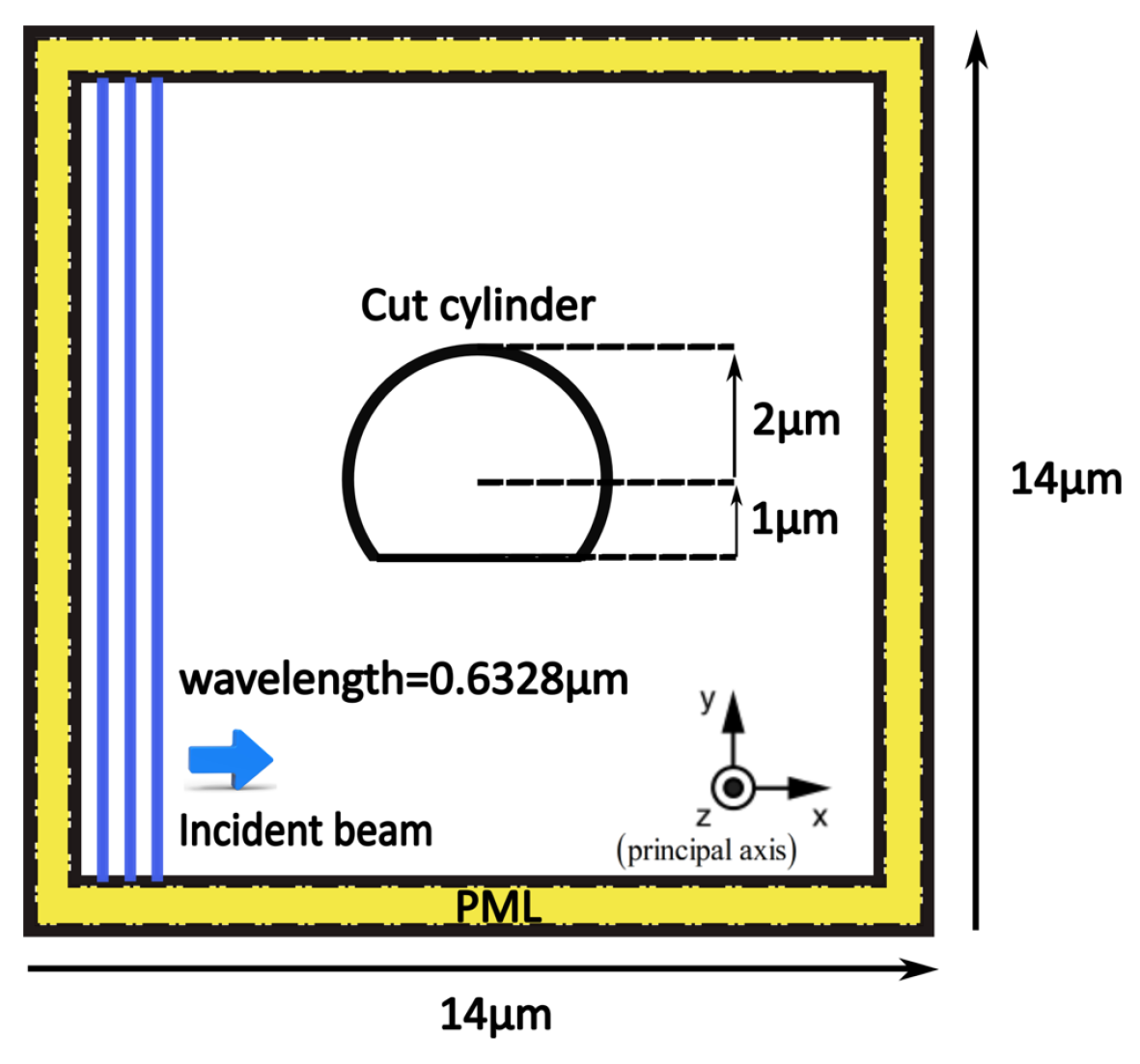


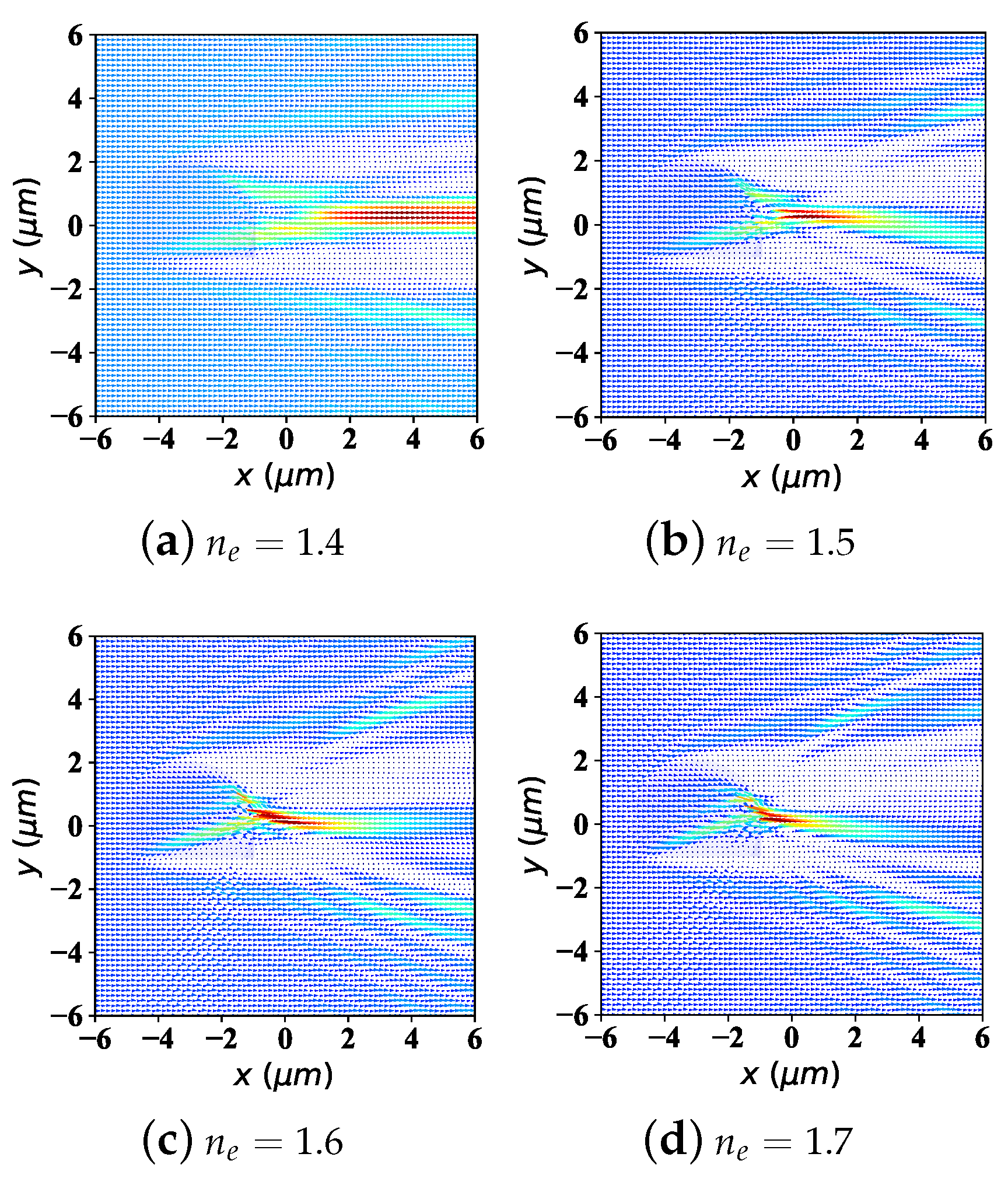
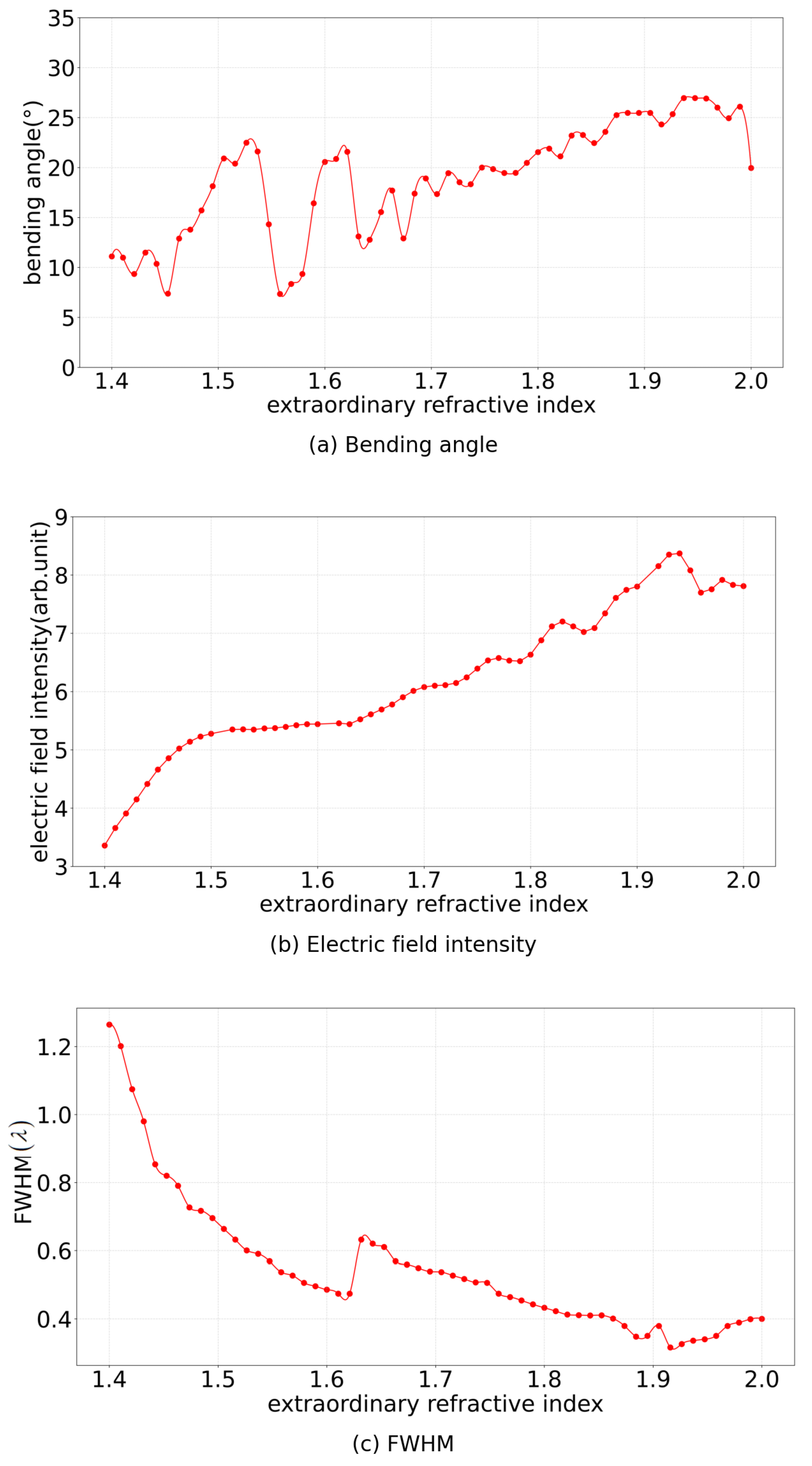

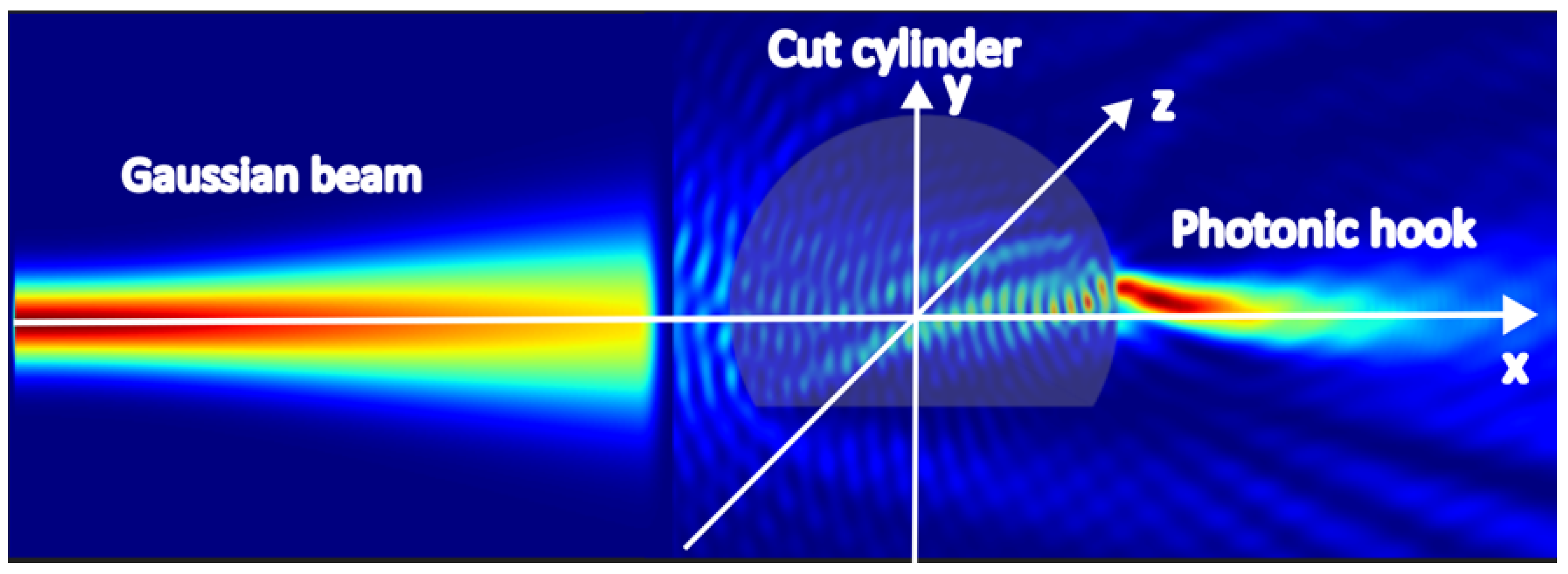
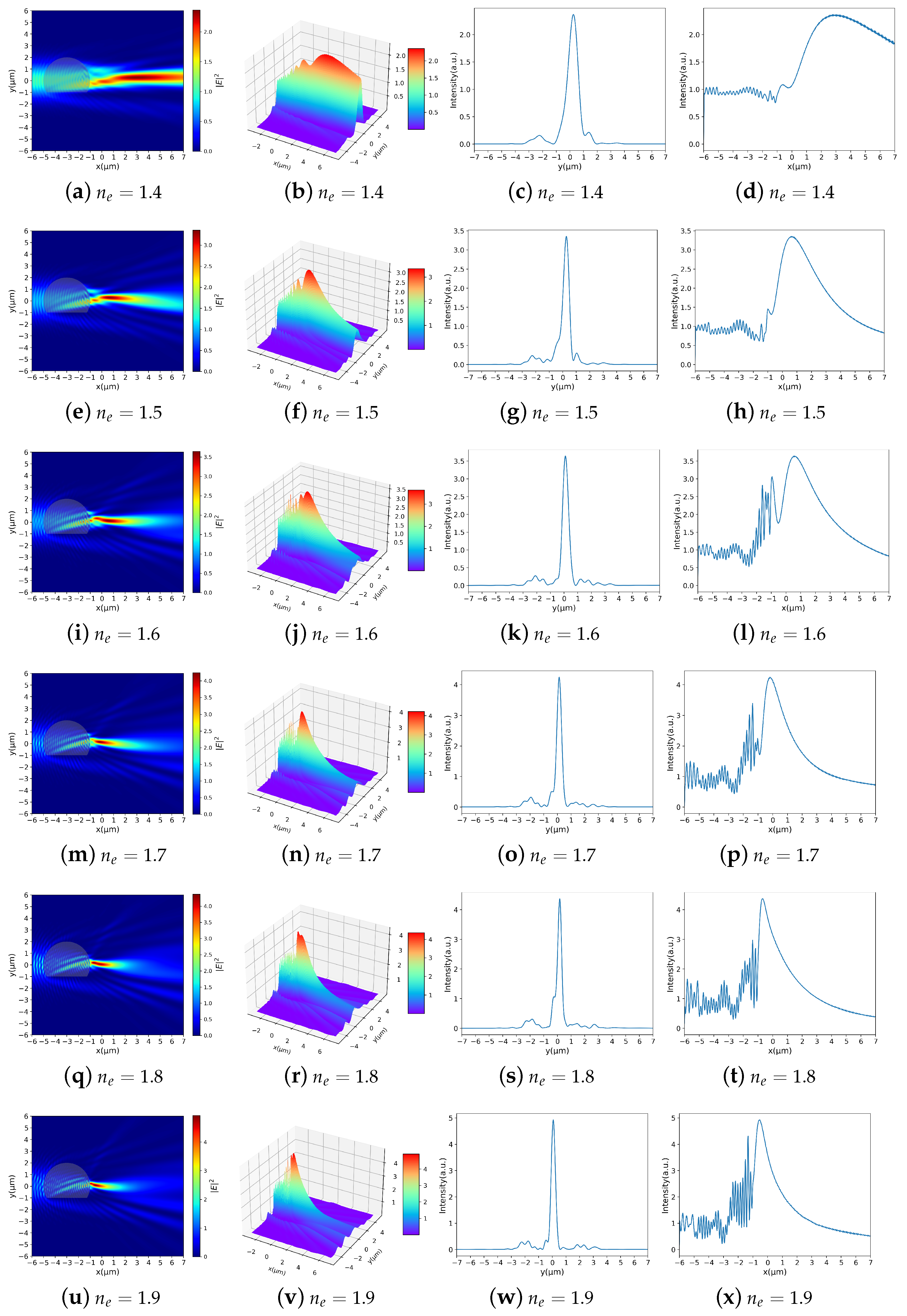
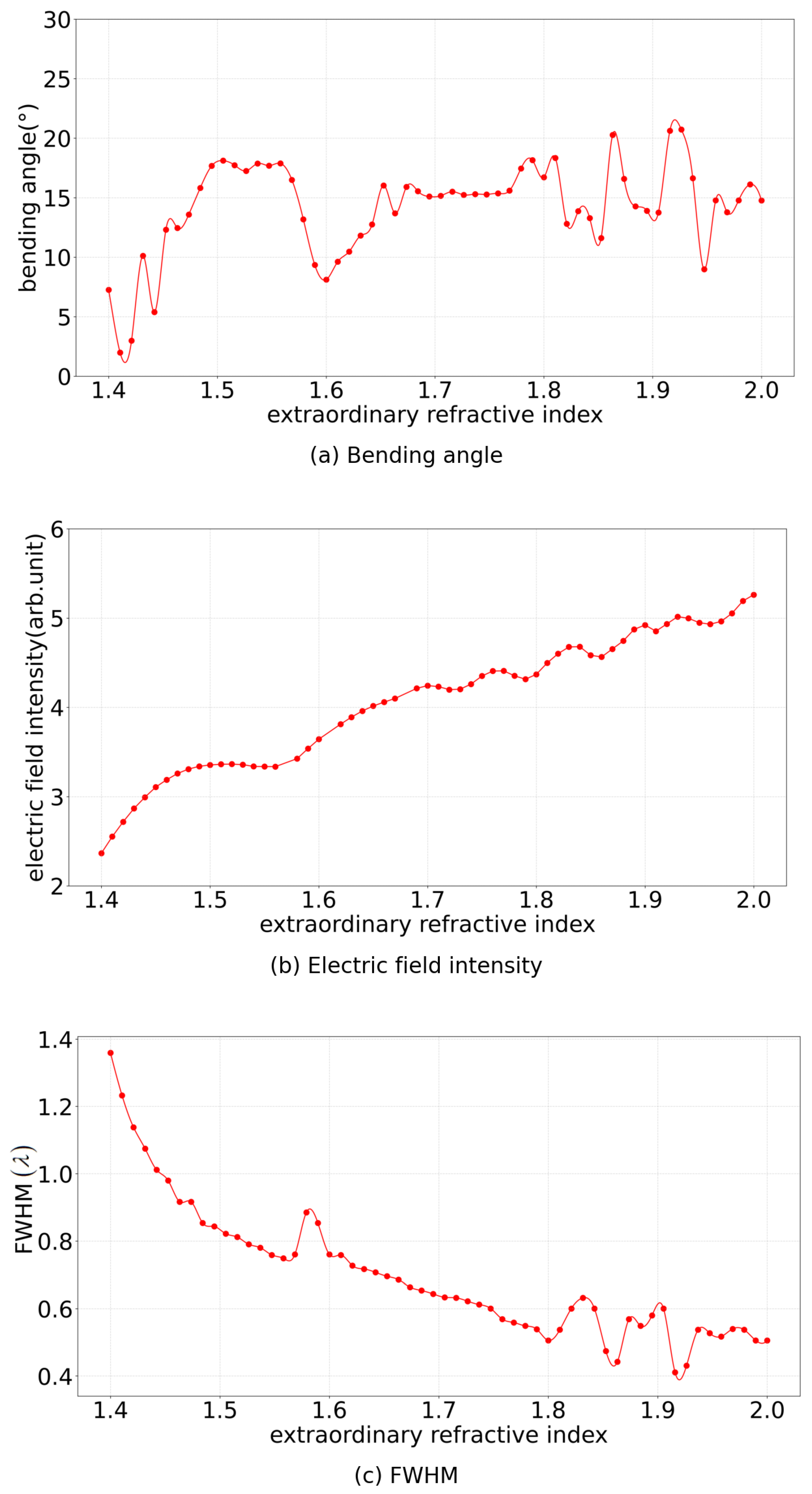
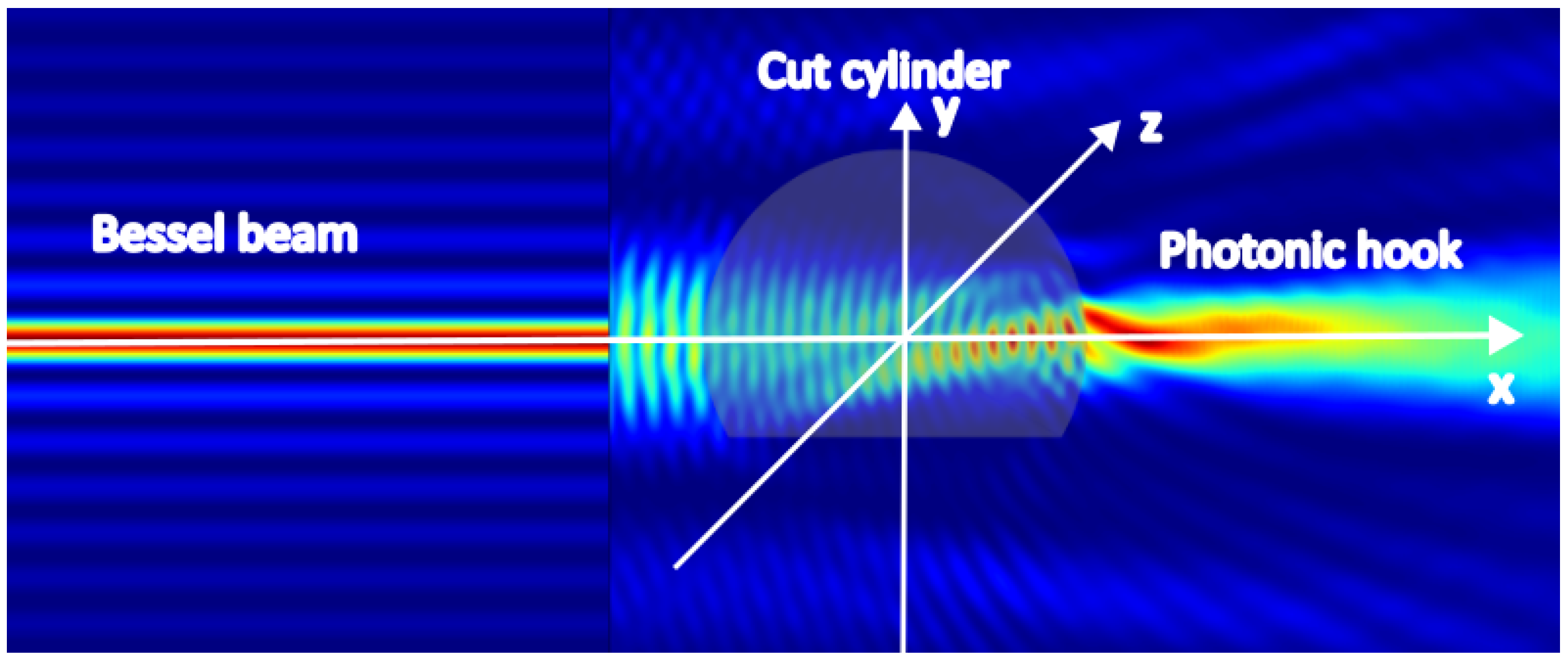

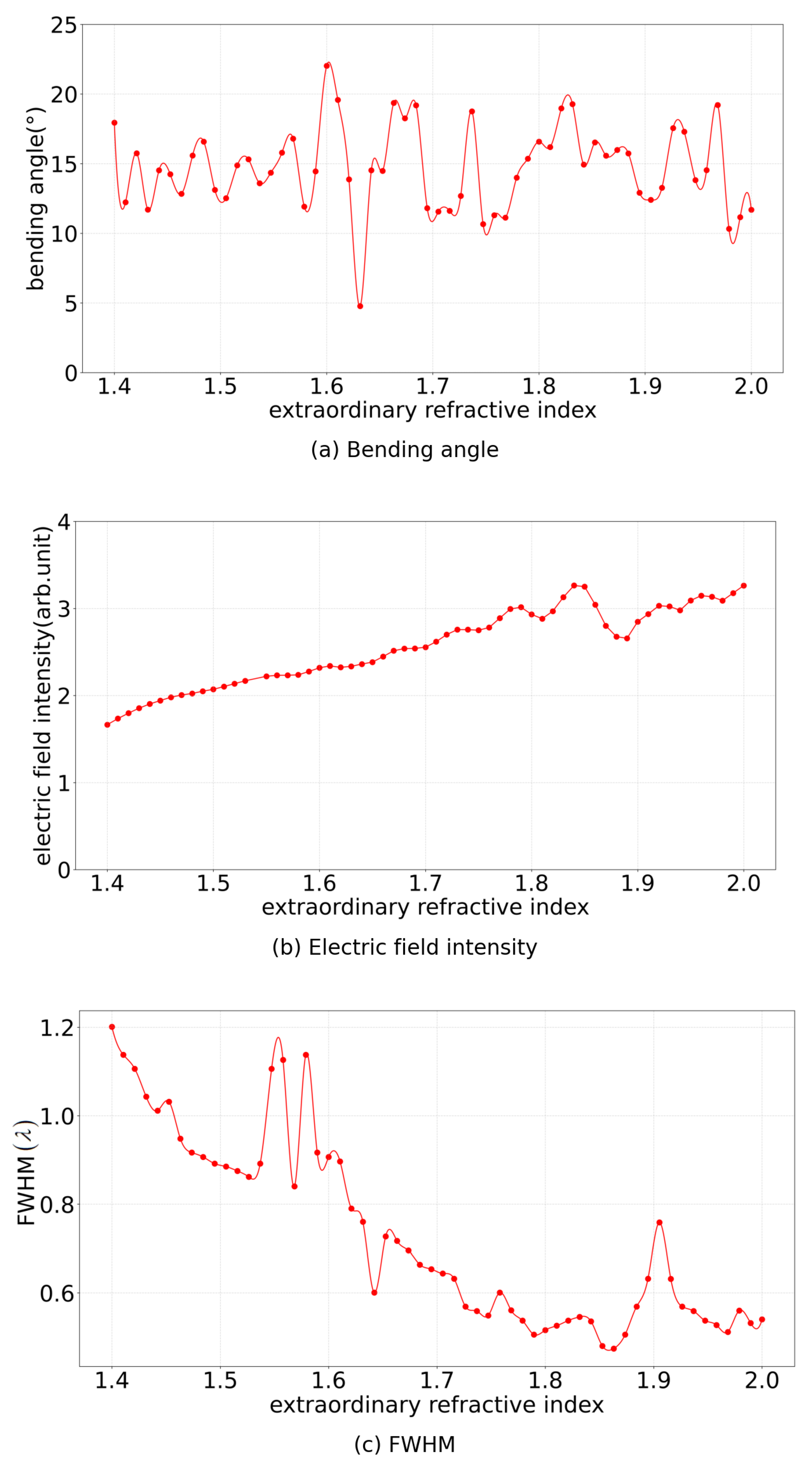
| Max Intensity (a.u.) | FWHM | Bending Angle | |
|---|---|---|---|
| 1.4 | 3.36 | 1.26 | −11.86° |
| 1.5 | 5.27 | 0.66 | −20.91° |
| 1.6 | 5.45 | 0.47 | +20.86° |
| 1.7 | 6.07 | 0.53 | +18.91° |
| 1.8 | 6.63 | 0.43 | +21.55° |
| 1.9 | 7.80 | 0.37 | +25.46° |
| Max Intensity (a.u.) | FWHM | Bending Angle | |
|---|---|---|---|
| 1.4 | 2.37 | 1.36 | −7.27° |
| 1.5 | 3.35 | 0.82 | −18.11° |
| 1.6 | 3.64 | 0.75 | +8.11° |
| 1.7 | 4.24 | 0.65 | +15.54° |
| 1.8 | 4.36 | 0.53 | +18.16° |
| 1.9 | 4.92 | 0.60 | +13.90° |
| Max Intensity (a.u.) | FWHM | Bending Angle | |
|---|---|---|---|
| 1.4 | 1.66 | 1.20 | −18.35° |
| 1.5 | 2.07 | 0.88 | −12.51° |
| 1.6 | 2.31 | 0.90 | +22.02° |
| 1.7 | 2.55 | 0.64 | +11.55° |
| 1.8 | 2.93 | 0.52 | +16.19° |
| 1.9 | 2.84 | 0.63 | +13.26° |
Disclaimer/Publisher’s Note: The statements, opinions and data contained in all publications are solely those of the individual author(s) and contributor(s) and not of MDPI and/or the editor(s). MDPI and/or the editor(s) disclaim responsibility for any injury to people or property resulting from any ideas, methods, instructions or products referred to in the content. |
© 2024 by the authors. Licensee MDPI, Basel, Switzerland. This article is an open access article distributed under the terms and conditions of the Creative Commons Attribution (CC BY) license (https://creativecommons.org/licenses/by/4.0/).
Share and Cite
Li, R.; Tang, H.; Zhang, M.; Liu, F.; Yang, R.; Khaleel, N.; Arfan, M.; Asif, M.; Minin, I.V.; Minin, O.V. Tunable Photonic Hook Design Based on Anisotropic Cutting Liquid Crystal Microcylinder. Photonics 2024, 11, 736. https://doi.org/10.3390/photonics11080736
Li R, Tang H, Zhang M, Liu F, Yang R, Khaleel N, Arfan M, Asif M, Minin IV, Minin OV. Tunable Photonic Hook Design Based on Anisotropic Cutting Liquid Crystal Microcylinder. Photonics. 2024; 11(8):736. https://doi.org/10.3390/photonics11080736
Chicago/Turabian StyleLi, Renxian, Huan Tang, Mingyu Zhang, Fengbei Liu, Ruiping Yang, Naila Khaleel, Muhammad Arfan, Muhammad Asif, Igor V. Minin, and Oleg V. Minin. 2024. "Tunable Photonic Hook Design Based on Anisotropic Cutting Liquid Crystal Microcylinder" Photonics 11, no. 8: 736. https://doi.org/10.3390/photonics11080736
APA StyleLi, R., Tang, H., Zhang, M., Liu, F., Yang, R., Khaleel, N., Arfan, M., Asif, M., Minin, I. V., & Minin, O. V. (2024). Tunable Photonic Hook Design Based on Anisotropic Cutting Liquid Crystal Microcylinder. Photonics, 11(8), 736. https://doi.org/10.3390/photonics11080736








